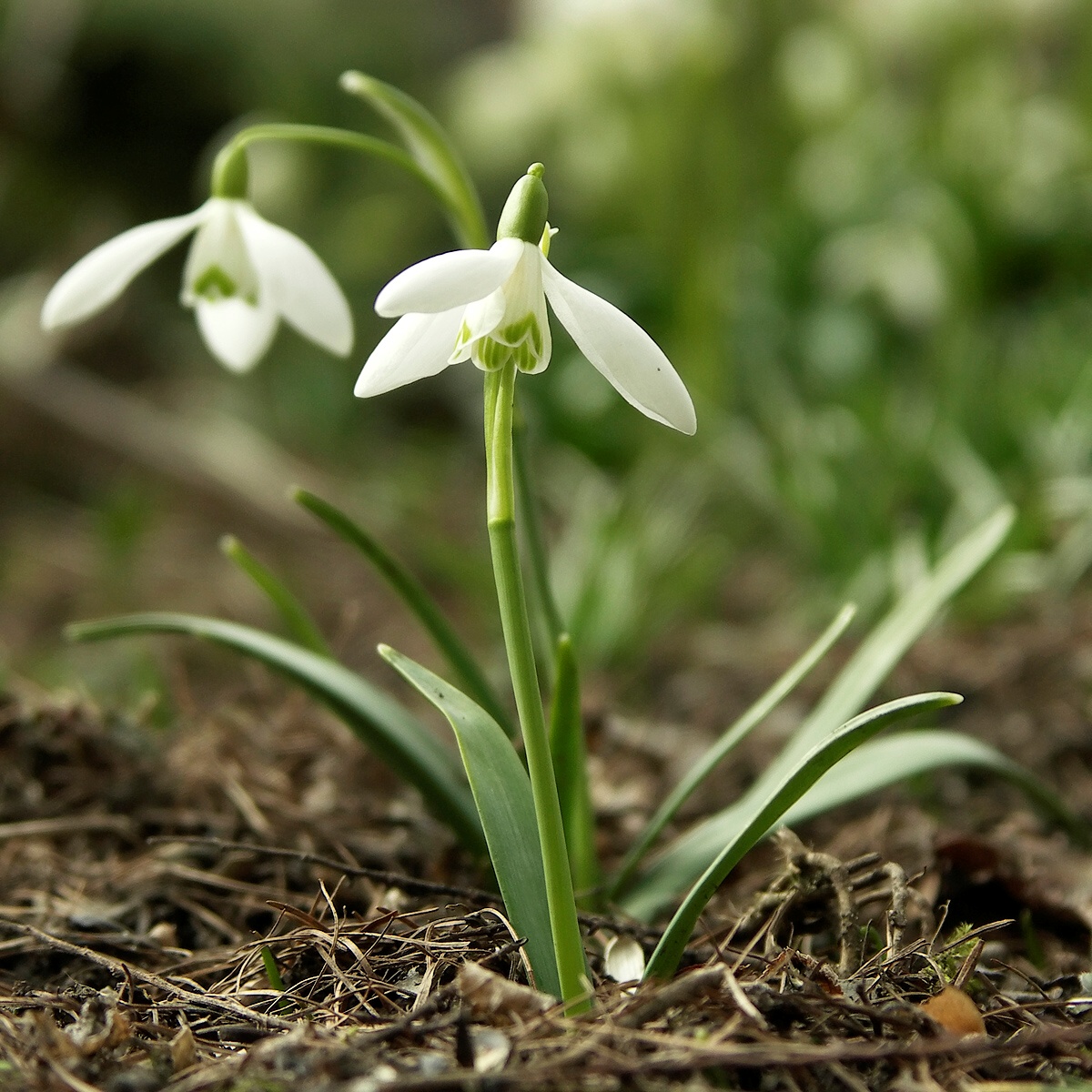Common
Snowdrops, Galanthus
nivalis,
are the most widespread of the 19 species in the genus Galanthus,
all of which are known as “snowdrops.”
 |
| Snowdrop, Galanthus nivalis [Source: Caroig] |
Snowdrops
occur from the Ukraine to the Pyrenees, and from Greece to Poland.
They are not actually native to the UK. The snowdrop wasn’t
recorded wild in the UK until the 1770s.1
They
are found in damp woods, streamsides, meadows, amongst scrub and in
shady gardens. Snowdrop flowers carpet the ground in the UK between
late January and early April. A carpet of snowdrops really is one of
the most beautiful natural sights in the UK.
 |
| Snowdrop Carpet [Source: Barry Deakin] |
Distinctive
features of the Snowdrop
Snowdrop
leaves are strap-like, and blue-green in colour. There are two
leaves, held flat against each other in bud.
Snowdrops
are famous for their simple but beautiful small, drooping white
flowers. Snowdrops have only one flower per stem. The stalk itself is
7-15cm long and is leafless.2
The
flower of the snowdrop consists six segments - three larger, white
ones on the outside, and three on the inside which have notches in
the tip. The inner flower segments have a green or green-ish yellow V
or U shaped mark towards the tip.3
 |
| Snowdrop Flower [Source: Darkone] |
The
fruit or seedhead is a small, near-spherical capsule containing tiny
pale brown seeds.
Winter
and Spring
Snowdrops
are known for being one of the earliest UK bulbs to flower. They are
traditionally seen to herald the end of the winter.
Snowdrops leaves have hardened tips, enabling the plant to appear early in the year, ever when the ground is hard, frozen or snow-covered.
| Snowdrops Emerging through the Snow [Source: J C D] |
The
flowering
stem is also covered in a small leaf-like spathe, or protective
sheath, enabling it to force its way through the hardened ground
along with the leaves.
The
snowdrop bud is erect at first. It will droop, becoming ‘pendant,’
later.4
The BBC has a time lapse video of snowdrops pushing up through the snow.
The
Many Names of the Snowdrop
The name “snowdrop” first appeared in the UK in the seventeenth century.
The name “snowdrop” first appeared in the UK in the seventeenth century.
Other
names for snowdrops are Candlemas bells, Mary’s taper, snow
piercer, flower of hope, February fairmaids, death’s flower and
dingle dangle.5
The
name “Candelmas Bells” refers to the belief in folklore that
snowdrops flower on Candlemas Day, 2 February.6
 |
| Candlemas Bells [Source: Tim Green] |
The
name “February fairmaids” also relates to Candlemas, which is
otherwise known as the Feast of Purification of St Mary, when village
maidens would wear snowdrops as symbols of purity.
The
name “Death's flower” relates to the belief that a single flower
indicates impending death.
The
Latin name for the common snowdrop is Galanthus
nivalis.
The genus name,
Galanthus,
means
milk-flower, and the species name nivalis
means
snowy.
Snowdrop
Reproduction
Most
snowdrops reproduce by division of the bulb rather than by
pollination.7
Bulb
division is a common method of reproduction in some plants. It is
asexual so avoids the hazards of sexual reproduction (seeds/flowers).
The snowdrop bulb is never truly dormant as the bulb is always
working on next year’s flowers and leaves.
Here
is a good summary of the different forms of asexual reproduction in
plants, including the snowdrop.
Insect
pollination does sometimes happen, in mild weather. The
inner petals of the snowdrop produce nectar, attracting foraging
bees. Snowdrops are a favourite flower for bees emerging from
hibernation early.8
Cultivating Snowdrops
The
snowdrop is cultivated widely and commonly planted in gardens and
parks in the UK. The snowdrop is one of the most popular of all
cultivated bulbous plants. Millions are sold every year.9
It is easy to grow. Once planted, snowdrops spread freely. They need
shade, and soil with good drainage.
There are numerous cultivars of snowdrops. Cultivators are plants selected for desirable characteristics which can be maintained by human-controlled propagation, a bit like the way different breeds of dog originated.
There are numerous cultivars of snowdrops. Cultivators are plants selected for desirable characteristics which can be maintained by human-controlled propagation, a bit like the way different breeds of dog originated.
A
popular and very ancient snowdrop cultivar is the double snowdrop,
which has 3-5 outer segments and 12-21 inners.
 |
| Double Snowdrops [Source: Jonathan Billinger] |
There are many many other cultivars, include giant snowdrops, snowdrops with long petals, and rare yellow kinds.
To
protect populations of the wild variety, international trade in wild
snowdrops is heavily restricted, and virtually ceased in 1995 with
the last exports from Hungary.10
Uses
of Snowdrops
Snowdrops are poisonous to humans, especially the bulbs. They can cause nausea, stomach ache, diarrhoea and vomiting. The most common reason snowdrop bulbs are consumed is by being mistaken for onions.11
Snowdrops are poisonous to humans, especially the bulbs. They can cause nausea, stomach ache, diarrhoea and vomiting. The most common reason snowdrop bulbs are consumed is by being mistaken for onions.11
The
snowdrop contains an alkaloid, galanthamine, that is used to slow the
progress of early onset Alzheimer’s disease. It was approved for
use in UK in 2010. Galanthamine is also used to treat traumatic
injuries to the nervous system.12
The
snowdrop is also an emmenagogue, meaning it stimulates menstrual flow
and so can induce abortion in early pregnancy.13
Snowdrop
lectin (GNA) is being studied for its potential in fighting HIV.
This lectin is already used as an insecticide against beetles,
butterflies and moths, aphids and leafhoppers.14
Strange
but True...
Snowdrops
flower a lot earlier than they used to.
In the 1950s they flowered at the end of February, but now it’s
January. This could be linked to the UK experiencing milder winters.
| Snowdrops Emerging Early [Source: Iris Wijngaarden] |
2http://www.kew.org/plants-fungi/Galanthus-nivalis.htm
4http://www.kew.org/plants-fungi/Galanthus-nivalis.htm
6http://www.thepoisongarden.co.uk/blog/blog160112.htm
8http://www.wildaboutplants.org.uk/wp-content/themes/plantlife/content/BeeSceneJan2011.pdf
11http://www.thepoisongarden.co.uk/atoz/galanthus_nivalis.htm
No comments:
Post a Comment